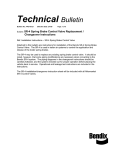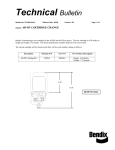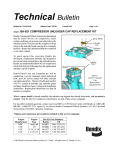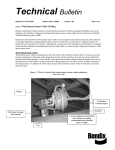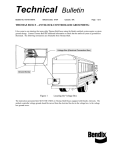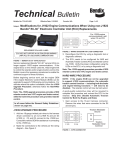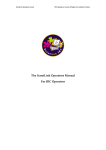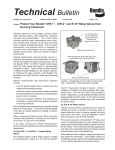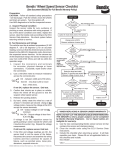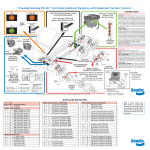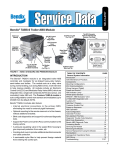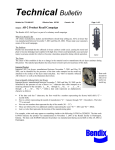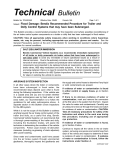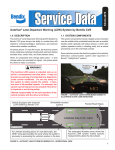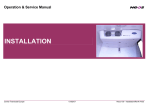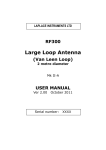Download BENDIX TCH-013-018 User's Manual
Transcript
Technical Bulletin Bulletin No: TCH-013-018 Subject: Effective Date: 8/24/2009 Cancels: N/A Page: 1 of 3 Bendix® AT-3™ Valve Leakage When installing valve components on a vehicle, including service replacement parts, the installer needs to carefully follow the installation guidelines. Not following these guidelines can lead to damage of the valve and reduced vehicle braking. Bendix Commercial Vehicle Systems LLC has identified that some Bendix® AT-3™ solenoid valve bodies have become damaged and may result in leakage. Bendix recommends that the crimp area of the AT-3™ valve be inspected and replace the valve if this area has been found to have become loose. See Figure 1. The Bendix® AT-3™ solenoid valve is a specialized air brake valve which may be used for several functions, depending on the specific vehicle needs. Most typically, the AT-3™ solenoid valve is used in the Bendix® ATC automatic traction control and Bendix® ESP® stability systems. See Figure 2 for typical applications of the Bendix AT-3™ solenoid valve. One or two of these valves may be installed on a vehicle. Crimp Area Valve Body Solenoid Body Supply Port Permitted Clamp Location Electrical Connector Clamp From Both Sides of Mounting Hole Flange Permitted Clamp Location Never Clamp Using Solenoid Body Mounting Holes Delivery Port Service / Exhaust Port FIGURE 1 - THE BENDIX® AT-3™ SOLENOID VALVE To identify if the AT-3™ solenoid valve on your vehicle is damaged, perform the following inspection. Follow all standard industry safety precautions, including, but not limited to, those included in this document. 1. Park the vehicle on a level surface and block the wheels and/or hold the vehicle by means other than the air brakes. 2. Drain the air pressure from all vehicle reservoirs. 3. Locate the AT-3™ solenoid valve(s) on the vehicle. See Figure 2. 4. With the valve mounted on the vehicle, grasp the solenoid body with your hand and attempt to rock it, checking for looseness of the crimp area. If the solenoid body moves, or rocks, then the valve is damaged and should be replaced. Replacement valves are available through any Bendix authorized parts distribution center. If a replacement valve is needed, be sure to follow the installation guidelines included with the valve to prevent damage to the replacement valve. Continued ... Bulletin No: TCH-013-018 Subject: Effective Date: 8/24/2009 Cancels: N/A Page: 2 of 3 Bendix® AT-3™ Valve Leakage From Trailer Control Valve ABS Modulator Quick Release Valve Piloted Relay Valve Foot Brake Valve Tractor Protection Valve Double Check Valve AT-3™ Solenoid Valve - Drive Axle (ATC / ESP) SER DEL Pressure Reducing Valve Trailer Modulator Valve ABS Modulator SUP Relay Valve SUP DEL EXH AT-3™ Solenoid Valve (HSA-Hill Start Aid) ABS Modulator SER DEL SUP ABS Modulator AT-3™ Solenoid Valve - Steer Axle (ESP) Supply Secondary Primary PRIMARY FIGURE 2 - EXAMPLE APPLICATIONS OF BENDIX® AT-3™ SOLENOID VALVE; 6X4 TRACTOR WITH TRACTION CONTROL, ELECTRONIC STABILITY AND HILL START AID WARNING! Please READ and follow these instructions to avoid personal injury or death: When working on or around a vehicle, the following general precautions should be observed at all times. 1. Park the vehicle on a level surface, apply the parking brakes, and always block the wheels. Always wear safety glasses. 2. Stop the engine and remove ignition key when working under or around the vehicle. When working in the engine compartment, the engine should be shut off and the ignition key should be removed. Where circumstances require that the engine be in operation, EXTREME CAUTION should be used to prevent personal injury resulting from contact with moving, rotating, leaking, heated or electrically charged components. 3. Do not attempt to install, remove, disassemble or assemble a component until you have read and thoroughly understand the recommended procedures. Use only the proper tools and observe all precautions pertaining to use of those tools. 4. If the work is being performed on the vehicle’s air brake system, or any auxiliary pressurized air systems, make certain to drain the air pressure from all reservoirs before beginning ANY work on the vehicle. If the vehicle is equipped with an AD-IS® air dryer system or a dryer reservoir module, be sure to drain the purge reservoir. 5. Following the vehicle manufacturer’s recommended procedures, deactivate the electrical system in a manner that safely removes all electrical power from the vehicle. 6. Never exceed manufacturer’s recommended pressures. 7. Never connect or disconnect a hose or line containing pressure; it may whip. Never remove a component or plug unless you are certain all system pressure has been depleted. 8. Use only genuine Bendix® replacement parts, components and kits. Replacement hardware, tubing, hose, fittings, etc. must be of equivalent size, type and strength as original equipment and be designed specifically for such applications and systems. 9. Components with stripped threads or damaged parts should be replaced rather than repaired. Do not attempt repairs requiring machining or welding unless specifically stated and approved by the vehicle and component manufacturer. 10. Prior to returning the vehicle to service, make certain all components and systems are restored to their proper operating condition. 11. For vehicles with Automatic Traction Control (ATC), the ATC function must be disabled (ATC indicator lamp should be ON) prior to performing any vehicle maintenance where one or more wheels on a drive axle are lifted off the ground and moving. Bulletin No: TCH-013-018 Subject: Effective Date: 8/24/2009 Cancels: N/A Page: 3 of 3 Bendix® AT-3™ Valve Leakage The following is for reference only and should not be used in lieu of the instructions provided with the service replacement valve. ASSEMBLY Note: All torques specified in this document are assembly torques and can be expected to fall off slightly after assembly. Do not re-torque after initial assembly torques fall. For assembly, use hand tools or torque limited drivers only. Do not use impact driver to install any fittings. Use a professional grade thread sealant on all air hose connections to this valve. INSTALLATION Bendix approves two methods of installation: (a) either install the valve onto the vehicle with OEM approved mounting bolts, and then attach the fittings, or, (b) bench installation of the fittings, using only the clamp location shown in Figure 1, before installing the valve on the vehicle. 1. Clean and inspect all air lines and electrical harnesses for damage and replace as necessary. Select one of the two fitting installation methods, either install the valve onto the vehicle first, or clamp, as shown in Figure 1, using a bench vise for steps 2 and 3. 2. With thread sealant applied, connect the (1/4-18 NPT) supply and delivery air lines to the valve to an initial torque of 15 ± 3 ft. lbs. The fittings may be oriented clockwise, no more than one (1) additional turn to its final position. 3. For vehicles where the service / exhaust port is used, apply thread sealant to the hose connector and tighten to 18 ft. lbs. (25 N•m). Where the fittings were installed using a bench vise, now install the valve onto the vehicle. 4. In cases where the service / exhaust port is open to the atmosphere, remember to install the valve with this port oriented downwards (within 30 degrees of vertical). Where used, re-install the snorkel tube retained during disassembly. Be sure to check that the snorkel tube has a constant downward slope. Consider installing a snorkel tube for open service ports in locations where road spray could enter the valve. 5. Reconnect the wire harness to the solenoid using the identification made during the REMOVAL step. Be sure to check that the harness has sufficient tiewraps, etc. to prevent any damage during vehicle operation. 6. Test valve as outlined in Operational and Leakage Tests. OPERATIONAL AND LEAKAGE TESTS 1. Chock the wheels, fully charge the air brake system and apply the brakes. 2. Coat the valve with a soap solution; leakage of a one-inch bubble in 3 seconds is permitted. Where the service / exhaust port is open to the atmosphere, do not spray the soap solution directly into this port, or snorkel tube, where installed. OPERATION TEST Since this valve is used for different functions depending on the vehicle, consult the vehicle Operator’s Manual for further information. For vehicles where this valve is being used for ATC functions, you may also refer to the Antilock Traction Controller’s Service Data sheet (visit www.bendix.com) for operational test(s) for traction functionality. In addition, for certain vehicle air brake systems, a PC with the Bendix® ACom™ Diagnostics software (BW2329) may be used to test the valve. BENDIX TECHNICAL ASSISTANCE TEAM For direct telephone technical support, call the Bendix Tech Team at: 1-800-AIR-BRAKE (1-800-247-2725), option 2 Monday through Friday, 8:00 A.M. to 6:00 P.M. EST, and follow the instructions in the recorded message, or you may e-mail: [email protected]. ©2009 Bendix Commercial Vehicle Systems LLC 8/09. All Rights Reserved. Printed in U.S.A.




